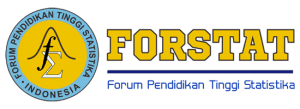PERAMALAN JUMLAH TITIK PANAS PROVINSI KALIMANTAN TIMUR MENGGUNAKAN METODE RADIAL BASIS FUNCTION NEURAL NETWORK
Abstract
Radial Basis Function Neural Network (RBFNN) is a neural that uses a radial base function in hidden layers for classification and forecasting purposes. Neural Network is developed into a radial function base with an information processing system that has characteristics similar to biological neural networks, consisting of input layers, hidden layers, and output layers. The data used in this study is data on the number of hotspots in East Kalimantan Province obtained from the official website of the National Aeronautics and Space Administration (NASA). The purpose of this research is to obtain the RBFNN model and the results of forecasting the number of hotspots for the period January 2020 to March 2020. The radial basis function used is the local Gaussian function and the linear activation function. In this study using the proportion of training data and testing data 70: 30; 80:20; and 90:10. The results showed that the input network using significant Partial Autocorrelation Function (PACF) at lag 1 and lag 2, so that the RBFNN model that was formed involved Xt-1 and Xt-2. The best Mean Absolute Percentage Error (MAPE) minimum obtained the 80:20 data proportion with 2 hidden networks. The RBFNN architecture that is formed is 2 input layers, 2 hidden layers and 1 output layer. Data from forecasting the number of hotspots in East Kalimantan Province shows that from January 2020 to February 2020 there was a decline and March 2020 an increase.
Keywords
Full Text:
PDFReferences
Aswi, A., and Sukarna, S. (2006), Analisis Deret Waktu Analisis Deret Waktu, Makassar: Andira Publisher.
Direktorat Pengendalian Kebakaran Hutan dan Lahan (2021), "SiPongi - Karhutla Monitoring Sistem" Available athttp://sipongi.menlhk.go.id/hotspot/luas_kebakaran.
Howlett, R. J., and Jain, L. C. (2001), Radial basis function networks 2: New Advances in Design, Mathematics Today, Berlin: Springer-Verlag.
Laksmi, P. I. O., Dharmawan, K., and Ida Harini, L. P. (2014), "Peramalan Kunjungan Wisatawan Menggunakan Model Armax Dengan Nilai Kurs Dan Ekspor-Impor Sebagai Faktor Eksogen" E-Jurnal Matematika, 3, 138. https://doi.org/10.24843/MTK.2014.v03.i04.p076
Makridakis, S., Wheelwright C, S., and McGee, V. E. (1999), Metode dan Aplikasi Peramalan, Binarupa Aksara.
Nievergelt, J. (1969), "R69-13 Perceptrons: An Introduction to Computational Geometry" IEEE Transactions on Computers, C-18, 572-572. https://doi.org/10.1109/T-C.1969.222718.
Nikentari, N., Bettiza, M., and Sastypratiwi, H. (2018), "Prediksi Kecepatan Angin Menggunakan Adaptive Neuro Fuzzy (ANFIS) dan Radial Basis Function Neural Network (RBFNN)" Jurnal Edukasi dan Penelitian Informatika (JEPIN), 4, 70. https://doi.org/10.26418/jp.v4i1.25558.
Palit, A. K., and PopovicÌ, D. (2005), Computational intelligence in time series forecasting : theory and engineering applications, London: Springer-Verlag.
Paliwal, M., and Kumar, U. A. (2009), "Neural networks and statistical techniques: A review of applications" Expert Systems with Applications, 36, 2-17. https://doi.org/10.1016/j.eswa.2007.10.005.
Prasetyo, E. (2012), Data Mining: konsep dan aplikasi menggunakan MATLAB, Yogyakarta: Andi.
Shoolihah, A.-M., Furqon, M. T., and Widodo, A. W. (2017), "Implementasi Metode Improved K-Means untuk Mengelompokkan Titik Panas Bumi" Jurnal Pengembangan Teknologi Informasi dan Ilmu Komputer (J-PTIIK) Universitas Brawijaya, 1, 1270-1276.
Tim Publikasi Kata Data (2019), "Luas Gambut Indonesia Terbesar Kedua di Dunia - Infografik Katadata.co.id" Available athttps://katadata.co.id/timpublikasikatadata/infografik/5e9a519433cb1/luas-gambut-indonesia-terbesar-kedua-di-dunia.
Warsito, B. (2009), Kapita Selekta Statistika Neural Network, Semarang: Badan Penerbit UNDIP Semarang.
DOI: https://doi.org/10.34312/jjps.v2i2.10292
Refbacks
- There are currently no refbacks.
Copyright (c) 2021 Jambura Journal of Probability and Statistics

This work is licensed under a Creative Commons Attribution-NonCommercial 4.0 International License.







.jpg)






